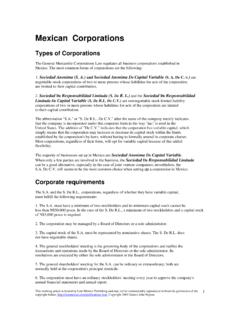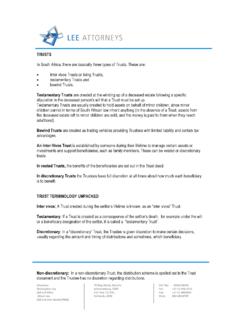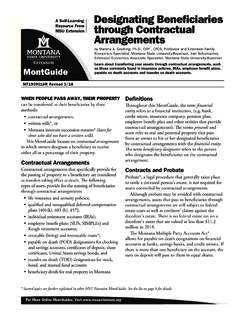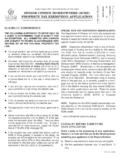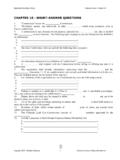Transcription of Glossary of Loan Terminology - Loanontime
1 Glossary of loan Terminology A B C D E F G H I J L M N O P Q R S T V Abstract (of Title) A historical summary of all the recorded transactions that affect the title to the property. An attorney or a title company will review an abstract of title to determine if there are any problems affecting the title to the property. All such problems must be cleared before the buyer can be issued a clear and insurable title. Abutting Bordering upon or next to; the joining or touching of adjoining land; sharing a common boundary. Acceleration Clause A loan provision giving the lender the power to declare all sums owing lender immediately due and payable upon the violation of a specific loan provision, such as the sale of the property, or the failure to make loan payments on time. Example: John sells his property to Mary who takes over John's mortgage payments.
2 They do not notify the lender of this transaction. The lender finds out that the title to the property has transferred and calls the loan , since the loan documents state that the loan is due on the sale of the property. John is now liable to pay his lender in full. Acceptance An offeree s consent to enter into a contract and be bound by the terms of the offer. In a real estate transaction an offer is made from the buyer to the seller. If the seller accepts the offer within the prescribed time limit, it becomes a binding contract. In this case Acceptance is documented by the Seller signing and delivering the signed document. Accretion The addition to land through natural forces like wind or water. Example: Soil carried by a river then deposited on land. Acknowledgment Formal declaration before a public official (typically a Notary Public) that one has signed a document.
3 Required before recording real estate legal documents, such as a deeds of trust. Acre A measure of land equal to 43,560 square feet. Additional Principal Payment A payment by a borrower of more than the scheduled principal amount due in order to reduce the remaining balance on the loan . Adjustable-rate mortgage (ARM) A mortgage in which the interest rate is adjusted periodically based on a pre-selected index. Also sometimes known as the re-negotiable rate mortgage, the variable rate mortgage or the Canadian rollover mortgage. View a list of common indexes. Indexes Your ARM is referenced to a particular index that changes. Lenders use that published index to serve as the basis for determining interest rate changes on adjustable rate mortgage loans. As the indices published rate fluctuates, so does your mortgage rate.
4 You can find these indices in the Wall Street Journal. The most commonly used indexes are: Treasury Indexed- Adjustments are based on the average interest rate that the government pays on its debt. CD Indexed (certificate of deposit) - Adjusts to certificate of deposit index. LIBOR (London interBank offer rate) - The rate on the dollar-denominated deposits, also known as Eurodollars, traded between banks in London. The LIBOR Index LIBOR stands for London Inter-Bank Offered Rate and is the interest rate at which highly rated American and International banks lend to one another. The LIBOR is an index that follows international economic conditions. There are various maturities associated with the LIBOR, including 1-month, 3-month, 6-month and 1-year. Use of LIBOR indices has increased due to the Treasury Department's decision to stop issuing shorter-term bonds like the One-Year Treasury bill in an effort to cut government costs.
5 The LIBOR has proven to be the most popular substitute to the US Treasury bill for Adjustable Rate Mortgages (ARMs). LIBOR-indexed ARMs offer aggressive initial rates. Borrowers are also protected from interest rate fluctuations by both periodic and lifetime interest rate caps. COFI (cost of funds index) - The cost of funds is indexed to the average interest rate that banks in particular states pay their customers. One of the most common indexes is the 11th district cost of funds index, which covers banks in California, Nevada and Arizona. Adjusted Basis The adjusted basis figure is the value used to determine capital gains when you sell real property. The original cost of a property plus the value of any capital expenditures for improvements to the property minus any depreciation taken. Adjustment date The date on which the interest rate changes for an adjustable-rate mortgage (ARM).
6 Adjustment period The length of time for which the interest rate is fixed on an adjustable. If the adjustment period is six months, then the interest rate will remain fixed for six months, after which time it will adjust. Affordability Analysis A detailed analysis to determine whether you can afford the purchase of a home. An affordability analysis takes into consideration your income, liabilities, and available funds, along with the type of mortgage you plan to use, the area where you want to purchase a home, and the closing costs that you might expect to pay. Agreement of Sale A written signed agreement between the seller and the purchaser in which the purchaser agrees to buy certain real estate and the seller agrees to sell upon terms of the agreement. Also known as contract of purchase, purchase agreement, offer and acceptance, earnest money contract or sales agreement.
7 Amenity A feature of real property that enhances its attractiveness and increases the occupant s or user s satisfaction, although the feature is not essential to the property s use. Natural amenities include a pleasant or desirable location near water, scenic views of the surrounding area, etc. Human-made amenities include swimming pools, tennis courts, community buildings, and other recreational facilities. Amortization The repayment of a mortgage loan by installments with regular payments to cover the principal and interest. Amortization term The amount of time required to amortize the mortgage loan . The amortization term is expressed as a number of months. For example, for a 30-year fixed-rate mortgage, the amortization term is 360 months. Annual Percentage Rate (APR) An interest rate reflecting the cost of a mortgage as a yearly rate The percentage relationship of the total finance charge to the amount of the loan , over the life of the loan .
8 Do not confuse APR with your quoted interest rate, which is used to determine your monthly principal and interest payment. The APR reflects the cost of our mortgage loan as a yearly rate. It will be higher than the interest rate stated on the note because it includes (in addition to the interest rate) loan points, fees and mortgage insurance. The APR allows home buyers to compare different types of mortgages based on the annual cost for each loan . Application A form, commonly referred to as a 1003 form, used to apply for a mortgage and to provide information regarding a prospective mortgagor and the proposed security. Appraisal A report written by a qualified expert Appraiser, that states an opinion on the value of a property based on its characteristics and the selling prices of similar or comparable properties in the area.
9 Appraiser A person qualified by education, training, and experience to estimate the value of real property and personal property. Appreciation An increase in the value of a property due to changes in market conditions or other causes. The opposite of depreciation. Asset Anything of monetary value that is owned by a person. Assets include real property, personal property, and enforceable claims against others (including bank accounts, stocks, mutual funds, and so on). Assessment The process of placing a value on property for the strict purpose of taxation. May also refer to a levy against property for a special purpose, such as a street or traffic light or sewer assessment. Assessment Rolls The public record of taxable property. Assignment The transfer of a mortgage from one person to another.
10 Assumable mortgage A mortgage loan which allows a new home buyer to take over the obligation of making loan payments with no change in the terms of the loan . Assumable loans do not have a due-on-sale clause. The lender has to be notified and agree to the assumption. The lender may require the buyer to qualify for the loan and may charge an assumption fee. The seller should obtain a written release from the lender stating clearly that he/she is no longer liable to make mortgage payments. Assumption The transfer of the seller's existing mortgage to the buyer, or taking over a loan and becoming personally liable for the repayment. Assumption clause A provision in an assumable mortgage that allows a buyer to assume responsibility for the mortgage from the seller. The loan does not need to be paid in full by the original borrower upon sale or transfer of the property.
